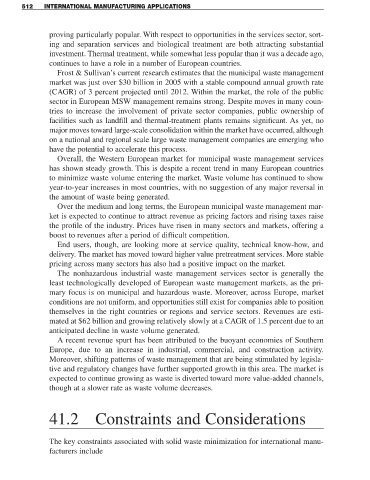Page 534 - Solid Waste Analysis and Minimization a Systems Approach
P. 534
512 INTERNATIONAL MANUFACTURING APPLICATIONS
proving particularly popular. With respect to opportunities in the services sector, sort-
ing and separation services and biological treatment are both attracting substantial
investment. Thermal treatment, while somewhat less popular than it was a decade ago,
continues to have a role in a number of European countries.
Frost & Sullivan’s current research estimates that the municipal waste management
market was just over $30 billion in 2005 with a stable compound annual growth rate
(CAGR) of 3 percent projected until 2012. Within the market, the role of the public
sector in European MSW management remains strong. Despite moves in many coun-
tries to increase the involvement of private sector companies, public ownership of
facilities such as landfill and thermal-treatment plants remains significant. As yet, no
major moves toward large-scale consolidation within the market have occurred, although
on a national and regional scale large waste management companies are emerging who
have the potential to accelerate this process.
Overall, the Western European market for municipal waste management services
has shown steady growth. This is despite a recent trend in many European countries
to minimize waste volume entering the market. Waste volume has continued to show
year-to-year increases in most countries, with no suggestion of any major reversal in
the amount of waste being generated.
Over the medium and long terms, the European municipal waste management mar-
ket is expected to continue to attract revenue as pricing factors and rising taxes raise
the profile of the industry. Prices have risen in many sectors and markets, offering a
boost to revenues after a period of difficult competition.
End users, though, are looking more at service quality, technical know-how, and
delivery. The market has moved toward higher value pretreatment services. More stable
pricing across many sectors has also had a positive impact on the market.
The nonhazardous industrial waste management services sector is generally the
least technologically developed of European waste management markets, as the pri-
mary focus is on municipal and hazardous waste. Moreover, across Europe, market
conditions are not uniform, and opportunities still exist for companies able to position
themselves in the right countries or regions and service sectors. Revenues are esti-
mated at $62 billion and growing relatively slowly at a CAGR of 1.5 percent due to an
anticipated decline in waste volume generated.
A recent revenue spurt has been attributed to the buoyant economies of Southern
Europe, due to an increase in industrial, commercial, and construction activity.
Moreover, shifting patterns of waste management that are being stimulated by legisla-
tive and regulatory changes have further supported growth in this area. The market is
expected to continue growing as waste is diverted toward more value-added channels,
though at a slower rate as waste volume decreases.
41.2 Constraints and Considerations
The key constraints associated with solid waste minimization for international manu-
facturers include

